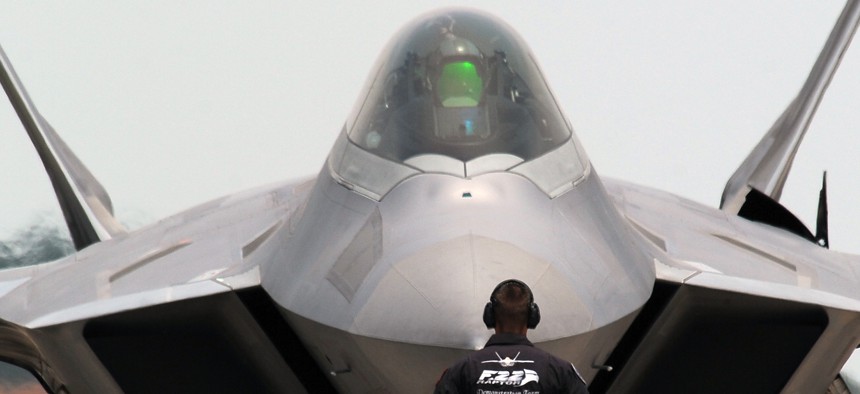
The U.S. Air Force’s F-22 Raptor Demonstration Team prepares to take off from Offutt Air Force Base, Neb., for the 2014 Defenders of Freedom Open House and Air Show July 19, 2014. U.S. Air Force photo by Josh Plueger
Pentagon Urged to Better Integrate Intel Needs in Weapons Acquisition
GAO says training and tighter certification would improve communication.
Modern U.S. weapons systems, from the F-22 stealth fighter to the F-35 Joint Strike Fighter, are increasingly designed with intelligence community requirements in mind. But the Defense Department has yet to iron out kinks in the communications chain during the complex acquisition process, a watchdog found.
The Pentagon has “developed certifications and training for acquisition and intelligence personnel, but it does not have certifications for certain personnel who provide intelligence support to acquisition programs,” the Government Accountability Office wrote in a report released on Nov. 1.
A DoD Acquisition Requirement Task Force begun in 2015 has identified the need for, but Defense has not required prioritization of, intelligence mission data, the watchdog found, while the extent of training and certification varies among the Army, Navy and Marine Corps. intelligence authorities.
With plans to invest as much as $1.6 trillion on acquiring 80 future major defense acquisition programs, the department must effectively integrate such intel-related technologies as radar signatures for sensors needed to detect enemies and airborne geospatial mapping devices, GAO noted in a report required under the fiscal 2016 National Defense Authorization Act.
Officials GAO interviewed in DoD’s Performance Assessments and Root Cause Analyses shops noted that “acquisition programs request intelligence both through informal means, such as conversations and emails, and through formal means via information systems.” But “formal requests for intelligence often contain vague or inaccurate information and do not allow the intelligence community to prioritize or fulfill requests efficiently.”
Last December, the offices of the Defense Secretary and the Defense Undersecretary for Acquisition, Technology and Logistics issued a memo creating a joint steering group to better integrate and prioritize intelligence input.
Currently, the department is developing two tools for integrating intelligence in acquisition. “One tool to share threat information lacks a communication plan to obtain feedback from users to better ensure its effectiveness,” auditors wrote. “Without user feedback, DoD may not receive useful information to develop the tool.”
The second tool, designed so that acquisition programs can communicate their intelligence needs to the intelligence community, is not in demand by the services and lacks a mechanism to fund its implementation, according to the report.
GAO recommended that Defense create certifications and training for intelligence support personnel, require that intelligence mission data be prioritized, develop a communication plan for a threat information tool, and determine whether another tool is needed.
Pentagon officials concurred with all four recommendations.
